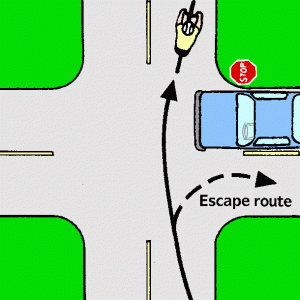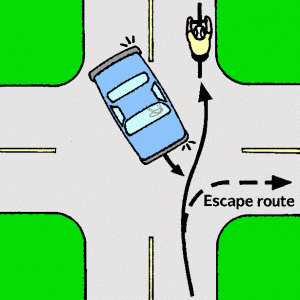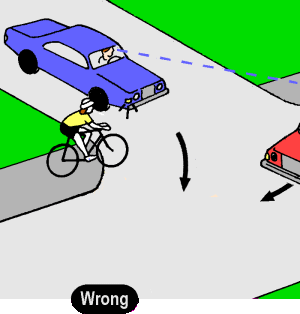Chapter 9
Dealing with Tough Situations
Let’s face it – some traffic situations go beyond the normal rules. When the traffic system begins to break down because of overcrowding, poor planning and disrespect for the law, you may have to “bushwhack” your way through the mess.
You can emerge safe and maintain the respect of other road users if you’re careful. Here are some situations where you have to take the initiative.
When Traffic Lights Don’t Turn
Always stop and wait for red lights. You not only ensure your safety, but you also increase respect for cyclists as law-abiding road users.
But some traffic lights don’t turn green until they receive a signal from a metal detector buried in the pavement. Some of these detectors do not respond to bicycles.
You can usually recognize the detector by a rectangular or octagonal pattern of thin lines in the pavement, where slots were cut for the detecting wires. The detector is most sensitive if you stop along one of the wires. If you lean your bicycle toward the middle of the detector, that may also help it to respond. If there are three parallel wires lengthwise in a lane, ride along the middle wire. Sometimes, the slots for the wires are not visible, because the street has been repaved since they were installed. But a marking on the pavement may show where to stop. In an increasing number of places, radar, ultrasonic, or video detection techniques are being used. These also may sometimes fail. At night, aiming your headlight at an overhead video detector may trigger it.
If your bicycle doesn’t trip the detector, you have to wait for a car to do it, or press a pedestrian button if there is one, or cautiously go through the red light. You couldn’t reasonably be held at fault for this, because the light is inoperative.
Detectors that work for bicycles are available at little or no additional cost. To promote better conditions for bicycling, alert your government officials about road conditions of any type that are unsafe for bicycling. Let them know that they are responsible to make the roadways safe for all types of vehicles, and that accommodation of bicycles is important to you. Getting involved at the local level can be very effective.
Getting Through Traffic Jams
Traffic jams don’t have to stop you – that’s one of the biggest advantages of bicycling in the city. But in the tight quarters of a tie-up, take extra care. Stopped cars in a traffic jam present the same hazards as parked cars: blindspots, suddenly opened doors, and unpredictable starts and turns.
If there is an open passing lane, use it rather than threading between cars. If the street is completely plugged, you might pick your way forward slowly with your hands on the brake levers. Remember, any car door could open!
In a traffic jam, you can be fairly sure that the cars will not move, since they have nowhere to go. But if there’s an open driveway or parking space into which a car could turn, you have to assume that it will. Look to see whether the car’s front wheels are turned. Move away from the side of the car as you pass, and try to get the driver’s attention as you approach the front of the car.
When cars are stopped, but not completely bumper to bumper, be very wary of cars cutting across in the gaps. Stop and look before you move out into a gap. Be especially careful if the vehicle you’re passing, like many vans, doesn’t have a hood you can see over. Even when spaces between vehicles are tight, a jaywalker could suddenly appear in front of you.
Don’t pass a long truck or bus in a traffic jam unless there’s a full, open lane next to it. Keep your distance. If you ride close to the side of such a vehicle, it may begin to merge toward you, leaving you no way to escape.
As you approach an intersection, change lanes to the same position as you would in normal traffic. Before you cross in front of a car to change lanes, make eye contact with the driver even if the car is stopped. When you reach an intersection, wait behind the first car at the traffic light. Don’t move up next to the first car. Drivers don’t always use their turn signals. You don’t know for sure which way the car will turn when the light turns green.
These traffic-jam tactics are reasonably safe, but in some places it is not legal for a bicyclist to pass on the right or ride between lanes of traffic. On the other hand, it’s usually legal for you, or any driver, cautiously to disobey normal traffic rules when the road is obstructed.
Sidewalk and Sidepath Riding
Many people consider sidewalks a safe place to ride because cars don’t travel on them. Unfortunately, sidewalks aren’t safe. Stay off them, except when you have no reasonable and legal alternative.
Trees, hedges, parked cars, buildings and doorways can create blindspots along a sidewalk, which is too narrow to allow you to swerve out of the way if someone appears. A pedestrian can burst out of a doorway at any time, or could sidestep suddenly, or a small child can run out from behind an adult. Never pass a pedestrian until you have his or her attention.
And cars do use sidewalks; they cross your path at every driveway and street. Ride very slowly and look in all directions before every crossing.
Similar cautions apply to paths located like sidewalks or behind parked cars. These are dangerous even when you are riding in the same direction as the traffic in the nearest lane – a driver turning across your path may not see you. The situation is even worse when you are traveling opposite traffic. Right-turning drivers entering from a side street normally look to the left for traffic and only glance to the right for slow pedestrians. When you are traveling opposite traffic at bicycle speeds you often are not where the motorist is looking. At night, you also may be blinded because you are on the bright side of car headlight beams.
Avoiding the Moving Blindspot
On most bicycles, you can see over many of the cars. You’ll become used to this advantage. Don’t let it fool you, though. You can’t see over a large SUV, van, truck or bus. Moving blindspots lurk behind these tall vehicles.
Suppose that you’re riding on a two-way, four-lane street. You’ve merged to the inside lane, because you want to turn left. You signal your left turn and continue to move forward. You see only one other vehicle on the street: a van, coming toward you in the opposite passing lane. It stops to let you turn left. Can you make your turn safely?

The moving blindspot: Motorist (a) has stopped as a favor to the bicyclist who is turning left. The bicyclist and motorist (b) have both seen the entire road at one time or another, but they have never seen each other.
No! Since you are moving forward, a blindspot behind the van is moving toward you. A car could be passing the van in the outside lane, and you would not see that car. If you were to cross in front of the van, you could be met with a terrible surprise.
Be wary when a motorist is trying to do you a favor, letting you proceed when the rules of the road would have you yield. Others may be operating according to the normal rules, and if your taking the favor leads to a collision, you can be held at fault.
Are You Invisible?
People will often tell you to “ride as if you were invisible.” That advice only makes sense where you’re actually hidden by a blindspot. To ride all the time as if you were invisible, you would have to pull off the road whenever a car approaches from behind. You would also have to stop and wait until traffic clears before crossing any intersection.
Instead, ride to make sure you’re visible. Wear bright-colored clothes day and night, and use lights and reflectors at night. Ride in the correct lane position where you can be seen. Also, test to make sure that drivers have seen you. This is the safest way to ride.
Making Eye Contact
How do you test that a driver has seen you? Here’s an example. Suppose that you are on a main street, riding toward an intersection. A car is approaching from the right in the cross street, where there’s a stop sign. How do you handle this situation?
As you approach the intersection, look into the car window and make eye contact with the driver to ascertain that the driver has seen you. Watch for the car to slow down more than it would if you weren’t there.
If you look into the driver’s window and the driver isn’t looking at you, then be very cautious. Even if the car is stopped at the stop sign, a driver who doesn’t know you’re there has no reason to stay stopped. Slow down, and call out to get the driver’s attention. Proceed only when you’re sure that the driver is waiting for you.
Dealing With Bad Drivers

To assert your right of way when a driver inches out from a stop sign, check behind you for traffic, merge left to draw the driver’s attention, and keep pedaling. Maintain an escape route.
Sometimes inattentive or rude drivers try to cut across in front of you. They may inch out from a driveway or stop sign and into your line of travel.
Watch for these poor behaviors and be prepared to deal with them safely. With a little experience, and after practicing the emergency braking and quick turn techniques in this booklet, you’ll be able to gauge each situation.
You keep yourself safe by being at the same time assertive – not aggressive – but also defensive. You can test the intentions of the driver while also being prepared to avoid a potential collision.

To assert your right of way when a driver threatens to turn left from ahead of you, check behind and merge left to make yourself more visible, then right to prepare your escape if necessary.
If a driver at a stop sign on driveway continues to move forward toward your line of travel, continue pedaling but be ready to brake or swerve early enough to avoid a collision. Your turning pedals are a clear signal that you intend to keep moving forward. Call out and try to make eye contact. Watch for the driver to respond by slowing or stopping. If there is any doubt whether the driver will yield right of way, let the driver proceed. Your goal should be to stay safe and maintain your right of way when possible.
Sometimes a left-turning motorist fails to yield to an oncoming bicyclist. A motorist must be going slowly before turning; learn to gauge whether a left turn is likely. Most left-turning motorists will yield if your intention to keep moving forward is clear, but if necessary you may avoid a potential collision with a quick turn to the right. You may brake if needed first, then turn after braking so you don’t end up directly in front of the left-turning car.
Also be alert for drivers who run stop signs or red lights without even slowing, or who stop and start again without looking – though these behaviors are so dangerous to the drivers themselves that they are quite rare.
Motorists will sometimes try to pass too close if you ride at the right edge of a narrow lane. You can normally prevent this by claiming the lane, as described in chapter 2, but if it happens anyway, keep steady and be prepared to move to the right, or even leave the road if you are being passed by a long vehicle that might turn right.
These are exceptional situations Most drivers will yield right of way as the traffic law requires. When they do, give a nod or wave of thanks.
Reporting Bad Drivers
If a motorist inadvertently or maliciously causes you to feel threatened or attempts to harm you, make note of the license plate number and, if possible, a description of the driver. You can report the incident to your local law enforcement agency, and in some states the Department of Motor Vehicles. If the offender is a commercial driver, inform the driver’s employer. You may be able to press criminal charges for assault if you believe the driver intentionally threatened a collision or someone in the vehicle threw something at you, or assault and battery if you were struck
In the Event of a Crash
After any fall or crash, seek appropriate medical attention, and before your next ride, have a qualified mechanic check that your bicycle is in safe working order.
Most bicycle crashes don’t involve other people, and can be prevented by good bicycle handling techniques. These crashes typically result from the bicyclist’s losing control on a bad surface or hitting a fixed object (see Moritz, William, Adult Bicyclists in the United States — Characteristics and Riding Experience, http://www.bicyclinglife.com/Library/Moritz2.htm. But if you are in a crash involving another person, first summon appropriate medical attention for all parties. Gather as much information at the scene as possible including the other parties’ names, addresses and insurance information. Keep in mind that you may not discover an injury, or damage to your bicycle, until later. Seek the advice of an attorney, especially if there is any dispute as to who was at fault. Be wary — many people including police officers and insurance officials do not understand bicyclists’ rights to the road and this may cause them to have a bias against you. For this reason, do not apologize or say anything that could be interpreted as an admission of fault and do not say that you are not hurt – you may not realize that you are injured until later. If the investigating officer takes a driver’s version of what happened and it differs from yours, politely insist that the police officer also record your version.
Reducing Friction Between Bicyclists and Motorists
The main way bicyclists annoy motorists is by performing unpredictable maneuvers this booklet warns against.
Fearful instruction – “always keep away from traffic” – is passed down to children by parents who don’t know much about bicycling – the blind leading the blind. From about 1930 to 1965, few adults rode bicycles in North America, and that was long enough for incorrect ideas about bicycling to become deeply rooted.
Certainly, children shouldn’t be allowed to ride bicycles in heavy traffic, any more than they should be allowed to drive cars. But that doesn’t mean that adult bicyclists should have to ride like children.
There will always be people in cars who yell, “Get off the road.” Don’t let them bother you. Position yourself to encourage drivers to maneuver around you correctly. If most bicyclists in your community use incorrect maneuvers, drivers may have some trouble understanding your correct maneuvers. You need to make especially clear signals. With experience, drivers will discover that they have an easier time with bicyclists who use correct maneuvers.
Summary
Your awareness of tough situations will help you anticipate and avoid problems and deal with problems that are unavoidable. Be courteous and respectful to other road users to avoid friction, but firmly assert your legal right to ride in the manner that is safe. Always be prepared to use your emergency maneuvers.


[drawing: “wrong” german=>english]
[illustration: as shown, the car is directly in front of the cyclist, who may “feel” safe and will simply stop (unless going too fast). More trouble can happen when the cyclist is tempted to maintain speed and cross in front of the car. If the car was further back relative to the cyclist it might better illustrate this danger; as shown it’s a few seconds later and, if the cyclist is not going very slowly it’s already too late. The drawing change could be done by both moving the sidewalk (and cyclist) closer to the road (narrowing the grass), and by moving the car back. Also, the red car appears angled on the roadway, as if pulling out of a parking space – seems better if it was a bit further out in the roadway going straight for this example. I know these changes are some work to accomplish but want to point them out for you to think about – I’m also ok to leave it as is if you want to show the problem later in time – maybe we could add something to the text regarding the cyclist’s speed, e.g. “You must ride very slowly and be prepared to stop quickly.”]
Some redundancy or two escape route photos with examples in chapter 5. ***AR: we decided to keep, see comments in ch5.
Under “Reporting bad drivers” it may be good to suggest using one’s cell phone to record details, either by typing a note or by doing a quick voice recording. Sometimes a photo is also possible. I once had an incident with an aggressive driver just before I came to a police station. I got the car’s license number and immediately stopped to tell the police. The police were very helpful, but in the heat of the moment, I had forgotten the license number.